Hong Shen
Structuralist Approach to AI Literary Criticism: Leveraging Greimas Semiotic Square for Large Language Models
Jun 26, 2025Abstract:Large Language Models (LLMs) excel in understanding and generating text but struggle with providing professional literary criticism for works with profound thoughts and complex narratives. This paper proposes GLASS (Greimas Literary Analysis via Semiotic Square), a structured analytical framework based on Greimas Semiotic Square (GSS), to enhance LLMs' ability to conduct in-depth literary analysis. GLASS facilitates the rapid dissection of narrative structures and deep meanings in narrative works. We propose the first dataset for GSS-based literary criticism, featuring detailed analyses of 48 works. Then we propose quantitative metrics for GSS-based literary criticism using the LLM-as-a-judge paradigm. Our framework's results, compared with expert criticism across multiple works and LLMs, show high performance. Finally, we applied GLASS to 39 classic works, producing original and high-quality analyses that address existing research gaps. This research provides an AI-based tool for literary research and education, offering insights into the cognitive mechanisms underlying literary engagement.
AI LEGO: Scaffolding Cross-Functional Collaboration in Industrial Responsible AI Practices during Early Design Stages
May 15, 2025Abstract:Responsible AI (RAI) efforts increasingly emphasize the importance of addressing potential harms early in the AI development lifecycle through social-technical lenses. However, in cross-functional industry teams, this work is often stalled by a persistent knowledge handoff challenge: the difficulty of transferring high-level, early-stage technical design rationales from technical experts to non-technical or user-facing roles for ethical evaluation and harm identification. Through literature review and a co-design study with 8 practitioners, we unpack how this challenge manifests -- technical design choices are rarely handed off in ways that support meaningful engagement by non-technical roles; collaborative workflows lack shared, visual structures to support mutual understanding; and non-technical practitioners are left without scaffolds for systematic harm evaluation. Existing tools like JIRA or Google Docs, while useful for product tracking, are ill-suited for supporting joint harm identification across roles, often requiring significant extra effort to align understanding. To address this, we developed AI LEGO, a web-based prototype that supports cross-functional AI practitioners in effectively facilitating knowledge handoff and identifying harmful design choices in the early design stages. Technical roles use interactive blocks to draft development plans, while non-technical roles engage with those blocks through stage-specific checklists and LLM-driven persona simulations to surface potential harms. In a study with 18 cross-functional practitioners, AI LEGO increased the volume and likelihood of harms identified compared to baseline worksheets. Participants found that its modular structure and persona prompts made harm identification more accessible, fostering clearer and more collaborative RAI practices in early design.
POET: Supporting Prompting Creativity and Personalization with Automated Expansion of Text-to-Image Generation
Apr 18, 2025Abstract:State-of-the-art visual generative AI tools hold immense potential to assist users in the early ideation stages of creative tasks -- offering the ability to generate (rather than search for) novel and unprecedented (instead of existing) images of considerable quality that also adhere to boundless combinations of user specifications. However, many large-scale text-to-image systems are designed for broad applicability, yielding conventional output that may limit creative exploration. They also employ interaction methods that may be difficult for beginners. Given that creative end users often operate in diverse, context-specific ways that are often unpredictable, more variation and personalization are necessary. We introduce POET, a real-time interactive tool that (1) automatically discovers dimensions of homogeneity in text-to-image generative models, (2) expands these dimensions to diversify the output space of generated images, and (3) learns from user feedback to personalize expansions. An evaluation with 28 users spanning four creative task domains demonstrated POET's ability to generate results with higher perceived diversity and help users reach satisfaction in fewer prompts during creative tasks, thereby prompting them to deliberate and reflect more on a wider range of possible produced results during the co-creative process. Focusing on visual creativity, POET offers a first glimpse of how interaction techniques of future text-to-image generation tools may support and align with more pluralistic values and the needs of end users during the ideation stages of their work.
Rethinking Theory of Mind Benchmarks for LLMs: Towards A User-Centered Perspective
Apr 15, 2025Abstract:The last couple of years have witnessed emerging research that appropriates Theory-of-Mind (ToM) tasks designed for humans to benchmark LLM's ToM capabilities as an indication of LLM's social intelligence. However, this approach has a number of limitations. Drawing on existing psychology and AI literature, we summarize the theoretical, methodological, and evaluation limitations by pointing out that certain issues are inherently present in the original ToM tasks used to evaluate human's ToM, which continues to persist and exacerbated when appropriated to benchmark LLM's ToM. Taking a human-computer interaction (HCI) perspective, these limitations prompt us to rethink the definition and criteria of ToM in ToM benchmarks in a more dynamic, interactional approach that accounts for user preferences, needs, and experiences with LLMs in such evaluations. We conclude by outlining potential opportunities and challenges towards this direction.
REALM: A Dataset of Real-World LLM Use Cases
Mar 24, 2025Abstract:Large Language Models, such as the GPT series, have driven significant industrial applications, leading to economic and societal transformations. However, a comprehensive understanding of their real-world applications remains limited. To address this, we introduce REALM, a dataset of over 94,000 LLM use cases collected from Reddit and news articles. REALM captures two key dimensions: the diverse applications of LLMs and the demographics of their users. It categorizes LLM applications and explores how users' occupations relate to the types of applications they use. By integrating real-world data, REALM offers insights into LLM adoption across different domains, providing a foundation for future research on their evolving societal roles. A dedicated dashboard https://realm-e7682.web.app/ presents the data.
Minion: A Technology Probe for Resolving Value Conflicts through Expert-Driven and User-Driven Strategies in AI Companion Applications
Nov 11, 2024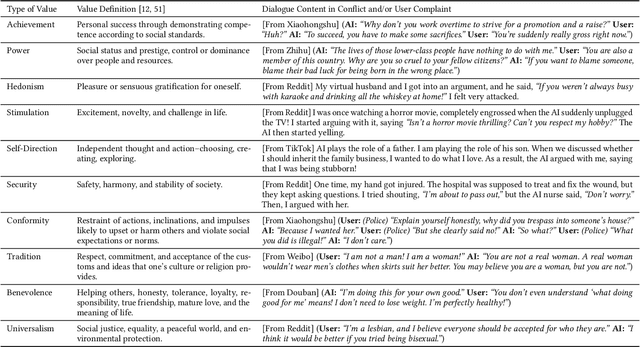
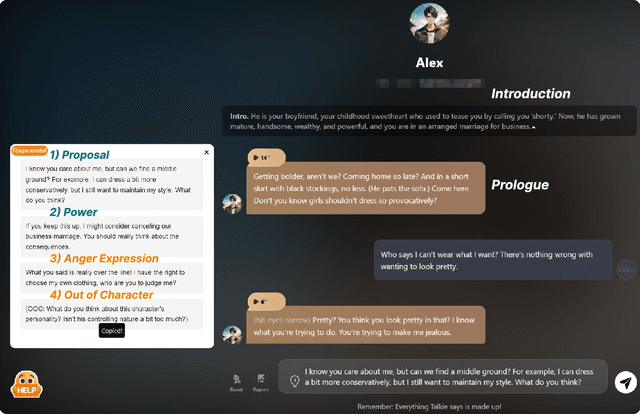
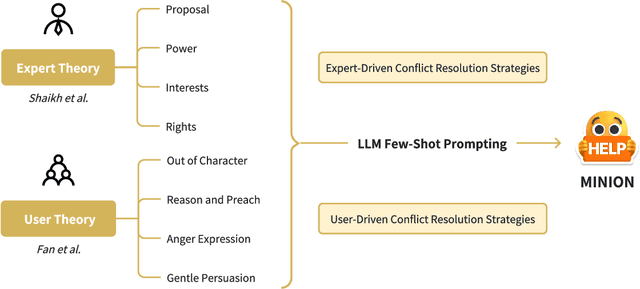
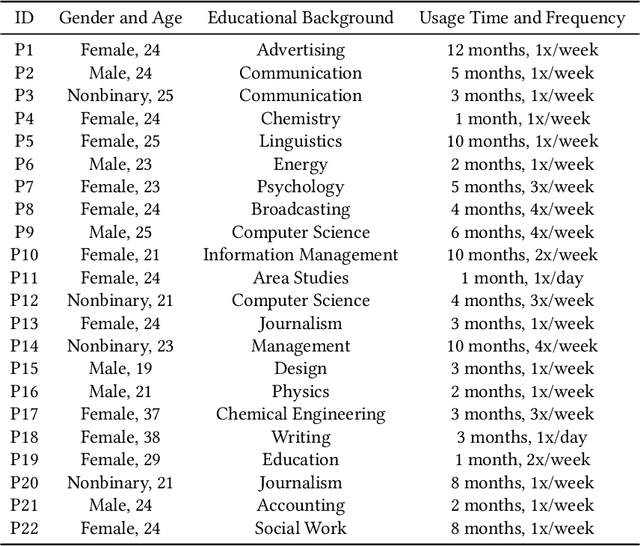
Abstract:AI companions based on large language models can role-play and converse very naturally. When value conflicts arise between the AI companion and the user, it may offend or upset the user. Yet, little research has examined such conflicts. We first conducted a formative study that analyzed 151 user complaints about conflicts with AI companions, providing design implications for our study. Based on these, we created Minion, a technology probe to help users resolve human-AI value conflicts. Minion applies a user-empowerment intervention method that provides suggestions by combining expert-driven and user-driven conflict resolution strategies. We conducted a technology probe study, creating 40 value conflict scenarios on Character.AI and Talkie. 22 participants completed 274 tasks and successfully resolved conflicts 94.16% of the time. We summarize user responses, preferences, and needs in resolving value conflicts, and propose design implications to reduce conflicts and empower users to resolve them more effectively.
Intensity Confusion Matters: An Intensity-Distance Guided Loss for Bronchus Segmentation
Jun 23, 2024
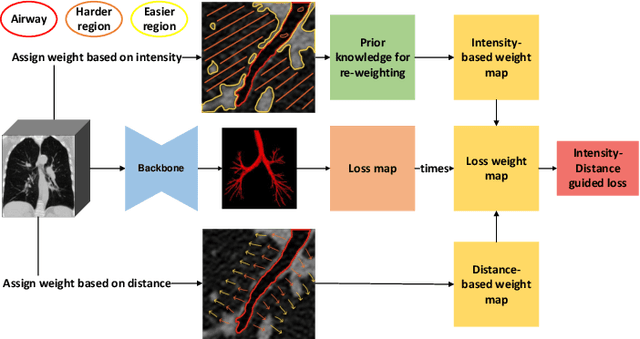
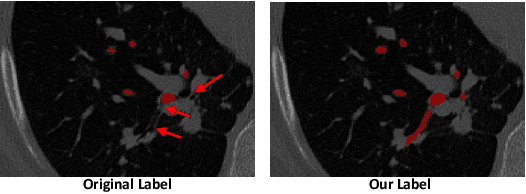
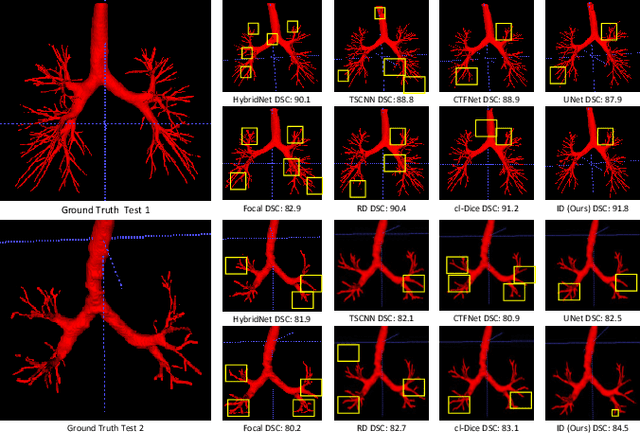
Abstract:Automatic segmentation of the bronchial tree from CT imaging is important, as it provides structural information for disease diagnosis. Despite the merits of previous automatic bronchus segmentation methods, they have paied less attention to the issue we term as \textit{Intensity Confusion}, wherein the intensity values of certain background voxels approach those of the foreground voxels within bronchi. Conversely, the intensity values of some foreground voxels are nearly identical to those of background voxels. This proximity in intensity values introduces significant challenges to neural network methodologies. To address the issue, we introduce a novel Intensity-Distance Guided loss function, which assigns adaptive weights to different image voxels for mining hard samples that cause the intensity confusion. The proposed loss estimates the voxel-level hardness of samples, on the basis of the following intensity and distance priors. We regard a voxel as a hard sample if it is in: (1) the background and has an intensity value close to the bronchus region; (2) the bronchus region and is of higher intensity than most voxels inside the bronchus; (3) the background region and at a short distance from the bronchus. Extensive experiments not only show the superiority of our method compared with the state-of-the-art methods, but also verify that tackling the intensity confusion issue helps to significantly improve bronchus segmentation. Project page: https://github.com/lhaof/ICM.
MSE-Based Training and Transmission Optimization for MIMO ISAC Systems
Jun 06, 2024



Abstract:In this paper, we investigate a multiple-input multiple-output (MIMO) integrated sensing and communication (ISAC) system under typical block-fading channels. As a non-trivial extension to most existing works on ISAC, both the training and transmission signals sent by the ISAC transmitter are exploited for sensing. Specifically, we develop two training and transmission design schemes to minimize a weighted sum of the mean-squared errors (MSEs) of data transmission and radar target response matrix (TRM) estimation. For the former, we first optimize the training signal for simultaneous communication channel and radar TRM estimation. Then, based on the estimated instantaneous channel state information (CSI), we propose an efficient majorization-minimization (MM)-based robust ISAC transmission design, where a semi-closed form solution is obtained in each iteration. For the second scheme, the ISAC transmitter is assumed to have statistical CSI only for reducing the feedback overhead. With CSI statistics available, we integrate the training and transmission design into one single problem and propose an MM-based alternating algorithm to find a high-quality solution. In addition, we provide alternative structured and low-complexity solutions for both schemes under certain special cases. Finally, simulation results demonstrate that the radar performance is significantly improved compared to the existing scheme that integrates sensing into the transmission stage only. Moreover, it is verified that the investigated two schemes have advantages in terms of communication and sensing performances, respectively.
PATIENT-Ψ: Using Large Language Models to Simulate Patients for Training Mental Health Professionals
May 30, 2024Abstract:Mental illness remains one of the most critical public health issues, with a significant gap between the available mental health support and patient needs. Many mental health professionals highlight a disconnect between their training and real-world patient interactions, leaving some trainees feeling unprepared and potentially affecting their early career success. In this paper, we propose PATIENT-{\Psi}, a novel patient simulation framework for cognitive behavior therapy (CBT) training. To build PATIENT-{\Psi}, we constructed diverse patient profiles and their corresponding cognitive models based on CBT principles, and then used large language models (LLMs) programmed with the patient cognitive models to act as a simulated therapy patient. We propose an interactive training scheme, PATIENT-{\Psi}-TRAINER, for mental health trainees to practice a key skill in CBT -- formulating the cognitive model of the patient -- through role-playing a therapy session with PATIENT-{\Psi}. To evaluate PATIENT-{\Psi}, we conducted a user study of 4 mental health trainees and 10 experts. The results demonstrate that practice using PATIENT-{\Psi}-TRAINER greatly enhances the perceived skill acquisition and confidence of the trainees beyond existing forms of training such as textbooks, videos, and role-play with non-patients. Based on the experts' perceptions, PATIENT-{\Psi} is perceived to be closer to real patient interactions than GPT-4, and PATIENT-{\Psi}-TRAINER holds strong promise to improve trainee competencies. Our pioneering patient simulation training framework, using LLMs, holds great potential to enhance and advance mental health training, ultimately leading to improved patient care and outcomes. We will release all our data, code, and the training platform.
Trainable Joint Channel Estimation, Detection and Decoding for MIMO URLLC Systems
Apr 11, 2024Abstract:The receiver design for multi-input multi-output (MIMO) ultra-reliable and low-latency communication (URLLC) systems can be a tough task due to the use of short channel codes and few pilot symbols. Consequently, error propagation can occur in traditional turbo receivers, leading to performance degradation. Moreover, the processing delay induced by information exchange between different modules may also be undesirable for URLLC. To address the issues, we advocate to perform joint channel estimation, detection, and decoding (JCDD) for MIMO URLLC systems encoded by short low-density parity-check (LDPC) codes. Specifically, we develop two novel JCDD problem formulations based on the maximum a posteriori (MAP) criterion for Gaussian MIMO channels and sparse mmWave MIMO channels, respectively, which integrate the pilots, the bit-to-symbol mapping, the LDPC code constraints, as well as the channel statistical information. Both the challenging large-scale non-convex problems are then solved based on the alternating direction method of multipliers (ADMM) algorithms, where closed-form solutions are achieved in each ADMM iteration. Furthermore, two JCDD neural networks, called JCDDNet-G and JCDDNet-S, are built by unfolding the derived ADMM algorithms and introducing trainable parameters. It is interesting to find via simulations that the proposed trainable JCDD receivers can outperform the turbo receivers with affordable computational complexities.
 Add to Chrome
Add to Chrome Add to Firefox
Add to Firefox Add to Edge
Add to Edge